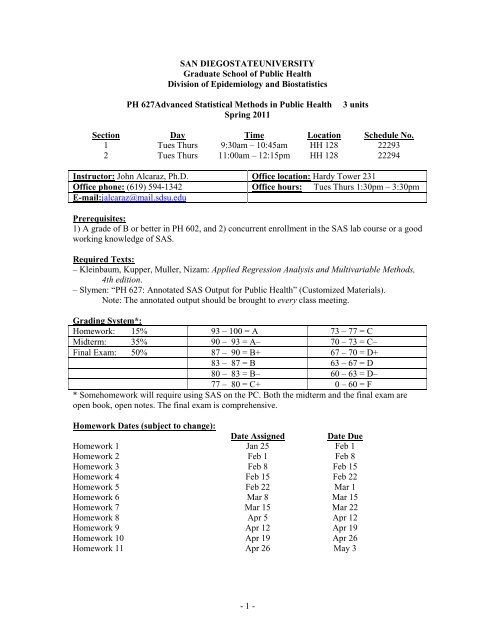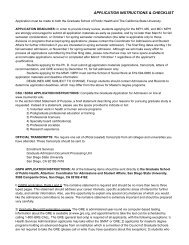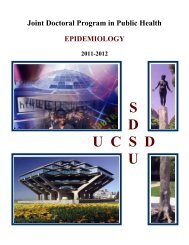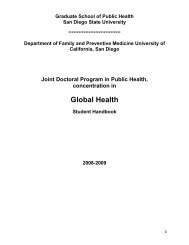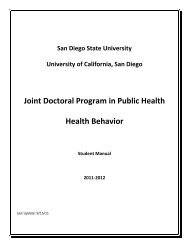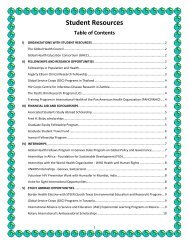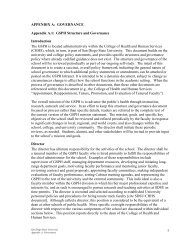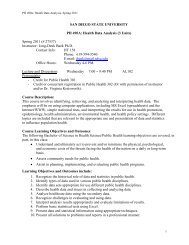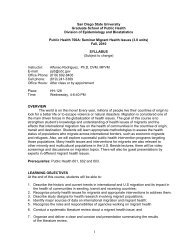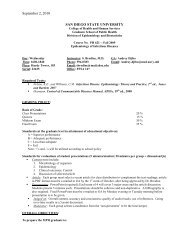PH 627-Alcaraz-s11.pdf - Graduate School of Public Health - San ...
PH 627-Alcaraz-s11.pdf - Graduate School of Public Health - San ...
PH 627-Alcaraz-s11.pdf - Graduate School of Public Health - San ...
You also want an ePaper? Increase the reach of your titles
YUMPU automatically turns print PDFs into web optimized ePapers that Google loves.
SAN DIEGOSTATEUNIVERSITY<br />
<strong>Graduate</strong> <strong>School</strong> <strong>of</strong> <strong>Public</strong> <strong>Health</strong><br />
Division <strong>of</strong> Epidemiology and Biostatistics<br />
<strong>PH</strong> <strong>627</strong>Advanced Statistical Methods in <strong>Public</strong> <strong>Health</strong> 3 units<br />
Spring 2011<br />
Section Day Time Location Schedule No.<br />
1 Tues Thurs 9:30am – 10:45am HH 128 22293<br />
2 Tues Thurs 11:00am – 12:15pm HH 128 22294<br />
Instructor: John <strong>Alcaraz</strong>, Ph.D. Office location: Hardy Tower 231<br />
Office phone: (619) 594-1342 Office hours: Tues Thurs 1:30pm – 3:30pm<br />
E-mail:jalcaraz@mail.sdsu.edu<br />
Prerequisites:<br />
1) A grade <strong>of</strong> B or better in <strong>PH</strong> 602, and 2) concurrent enrollment in the SAS lab course or a good<br />
working knowledge <strong>of</strong> SAS.<br />
Required Texts:<br />
– Kleinbaum, Kupper, Muller, Nizam: Applied Regression Analysis and Multivariable Methods,<br />
4th edition.<br />
– Slymen: “<strong>PH</strong> <strong>627</strong>: Annotated SAS Output for <strong>Public</strong> <strong>Health</strong>” (Customized Materials).<br />
Note: The annotated output should be brought to every class meeting.<br />
Grading System*:<br />
Homework: 15% 93 – 100 = A 73 – 77 = C<br />
Midterm: 35% 90 – 93 = A– 70 – 73 = C–<br />
Final Exam: 50% 87 – 90 = B+ 67 – 70 = D+<br />
83 – 87 = B 63 – 67 = D<br />
80 – 83 = B– 60 – 63 = D–<br />
77 – 80 = C+ 0 – 60 = F<br />
* Somehomework will require using SAS on the PC. Both the midterm and the final exam are<br />
open book, open notes. The final exam is comprehensive.<br />
Homework Dates (subject to change):<br />
Date Assigned Date Due<br />
Homework 1 Jan 25 Feb 1<br />
Homework 2 Feb 1 Feb 8<br />
Homework 3 Feb 8 Feb 15<br />
Homework 4 Feb 15 Feb 22<br />
Homework 5 Feb 22 Mar 1<br />
Homework 6 Mar 8 Mar 15<br />
Homework 7 Mar 15 Mar 22<br />
Homework 8 Apr 5 Apr 12<br />
Homework 9 Apr 12 Apr 19<br />
Homework 10 Apr 19 Apr 26<br />
Homework 11 Apr 26 May 3<br />
- 1 -
Exam Dates and Times (subject to change):<br />
Part 1 (in-class) Part 2 (in-class)<br />
Section 1<br />
Midterm Mar 22 (9:30am – 10:45am) Mar 24 (9:30am – 10:45am)<br />
Final May 10 (9:30am – 10:45am) May 17 (8:00am – 10:00am)<br />
Section 2<br />
Midterm Mar 22 (11:00am – 12:15pm) Mar 24 (11:00am – 12:15pm)<br />
Final May 10 (11:00am – 12:15pm) May 19 (10:30am – 12:30pm)<br />
Academic Ethics:<br />
SDSU has a strict code <strong>of</strong> ethical conduct which students are expected to follow.<br />
Seehttp://csrr.sdsu.edu/conduct1.htmlfor details. In particular, cheating will not be tolerated. You<br />
may not work together on the midterm or final exam, may not copy other students’ work, and<br />
may not allow other students to copy your work. Anyone caught cheating will face disciplinary<br />
action.<br />
Attendance/Punctuality:<br />
While attendance is not required except for exam dates, students are strongly encouraged to<br />
attend every class meeting and to be punctual. On exam dates, the exam will start and end at<br />
exactly the times listed above. Those who arrive late on exam dates will not be allowed to work<br />
past the end time to complete their exams.<br />
If you miss an exam because <strong>of</strong> severe circumstances (such as illness, injury, death in the family),<br />
please contact me no later than one week after the exam to arrange a makeup test.<br />
Students for whom an exam falls on a date <strong>of</strong> religious observance should contact me by the end<br />
<strong>of</strong> the second week <strong>of</strong> classes to discuss alternative arrangements.<br />
Students with Disabilities:<br />
Students with disabilities should discuss with me privately any specific accommodations for<br />
which they have received authorization. Authorization may be obtained by contacting Student<br />
Disability Services at 619-594-6473 (Calpulli Center, Suite 3101). Please obtain authorization<br />
before making an appointment to see me.<br />
- 2 -
Learning Objectives:<br />
Upon completion <strong>of</strong> this course the student will learn the appropriate use <strong>of</strong> advanced statistical<br />
methods for the analysis <strong>of</strong> data with continuous and binary responses, and the analysis <strong>of</strong><br />
survival data. Emphasis will be placed on regression techniques where multivariable adjustment<br />
and the simultaneous evaluation <strong>of</strong> risk factors are required.<br />
Specific objectives are:<br />
1) To describe the basic mathematical models used in multiple linear regression, analysis <strong>of</strong><br />
variance, logistic regression, and survival analysis. This includes a description <strong>of</strong> model<br />
assumptions, parametric estimation, confidence intervals, and hypothesis testing. Although this<br />
course does not require the use <strong>of</strong> calculus, some lectures will outline the underlying mathematics<br />
required to derive important results.<br />
2) To choose the appropriate models in solving specific public health problems, and to be aware<br />
<strong>of</strong> their strengths and limitations.<br />
3) To interpret correctly the results from fitting these models to data, and to write appropriate<br />
summaries for theses and reports.<br />
4) To acquire the basic technical skills needed to analyze data using these methods. This will be<br />
accomplished through examples <strong>of</strong> SAS output discussed in class and the SAS lab course.<br />
These objectives should contribute to your ability to critically review the public health and<br />
epidemiologic literature, and to carry out statistical analyses independently for your thesis and<br />
later pr<strong>of</strong>essional work.<br />
Note: It is assumed that students know the material in <strong>PH</strong>602 including simple linear regression<br />
and one-way ANOVA. If necessary, review the relevant portions <strong>of</strong> your <strong>PH</strong> 602 texts.<br />
- 3 -
Course Outline for <strong>PH</strong> <strong>627</strong> *<br />
Approx #<br />
Topic Sem Hrs. Book Chapters<br />
Regression: Continuous response<br />
Displaying results in ANOVA table 1 7<br />
Multiple regression 4 8 & 9<br />
Multiple and partial correlation 2 10<br />
Confounding and interaction 1 11<br />
Dummy variables 2 12<br />
Analysis <strong>of</strong> covariance 2 13<br />
Analysis <strong>of</strong> variance<br />
One-way 1 17<br />
Random vs fixed effects 1 17<br />
Multiple comparisons 1 17<br />
Two-way 5<br />
One observation per cell 18<br />
> 1 observation per cell<br />
Equal cells 19<br />
Unequal cells 20<br />
Regression: Binary response 22<br />
Introduction to logistic regression 2<br />
Adjusted odds ratio 1<br />
Maximum likelihood estimation 1<br />
Confidence intervals & hypothesis testing 2<br />
Modeling issues 2<br />
Analysis <strong>of</strong> survival data **<br />
Concepts & examples 1<br />
Functions <strong>of</strong> survival time 1<br />
Estimation: Product-limit estimate 1<br />
Life tables 1<br />
Two-sample problem: Log-rank & generalized Wilcoxon tests 2<br />
Regression- Cox proportional hazards model<br />
Concepts 2<br />
Estimation & hypothesis testing 3<br />
Modeling issues 3<br />
* Lecture notes for all topics will be available on Blackboard.<br />
** Readings for survival analysis will be available on Blackboard.<br />
- 4 -


